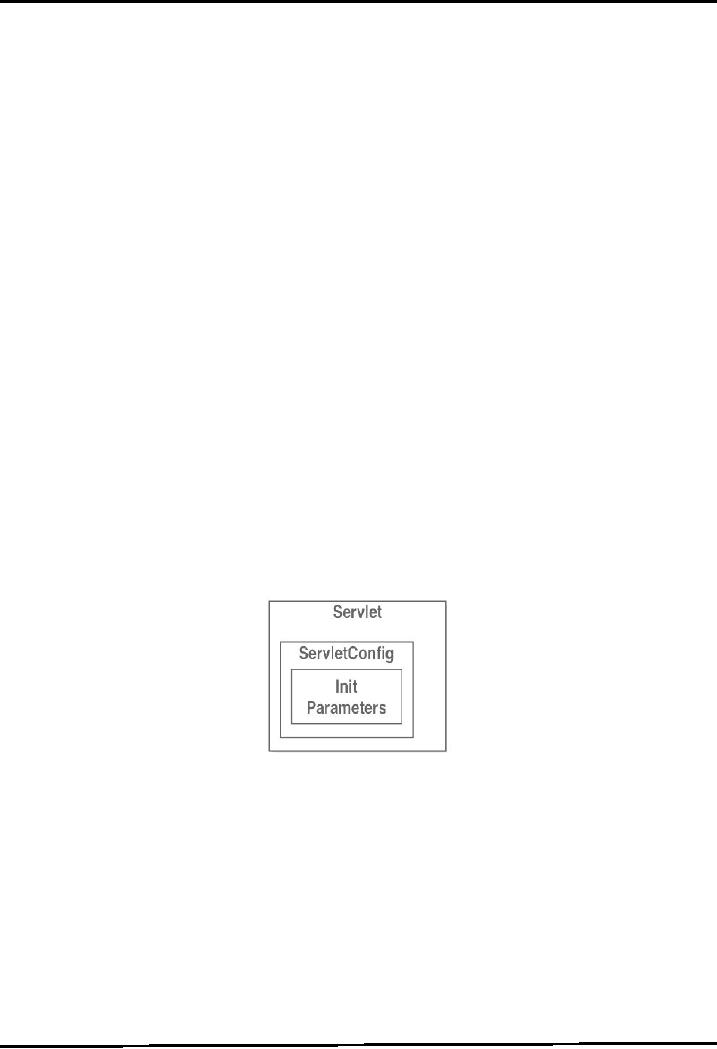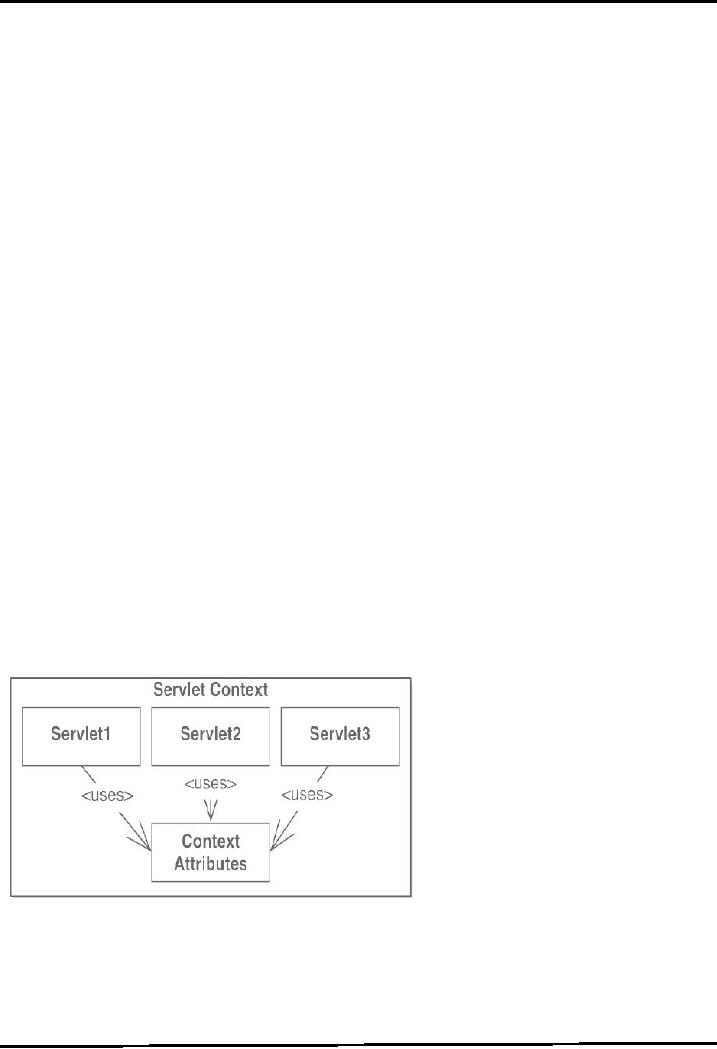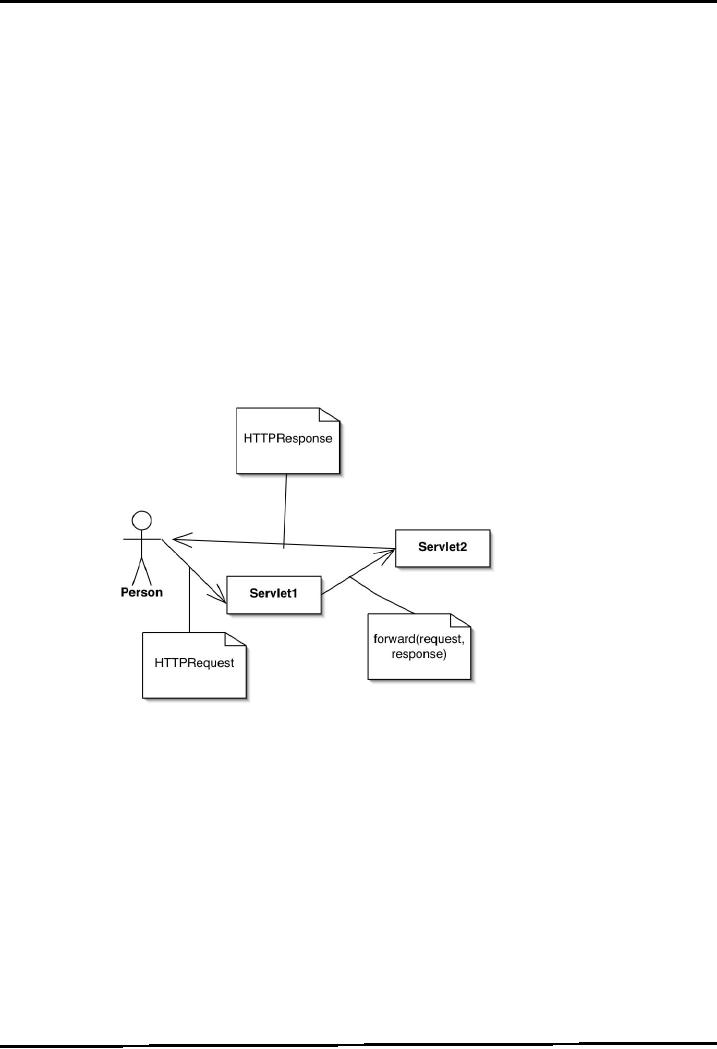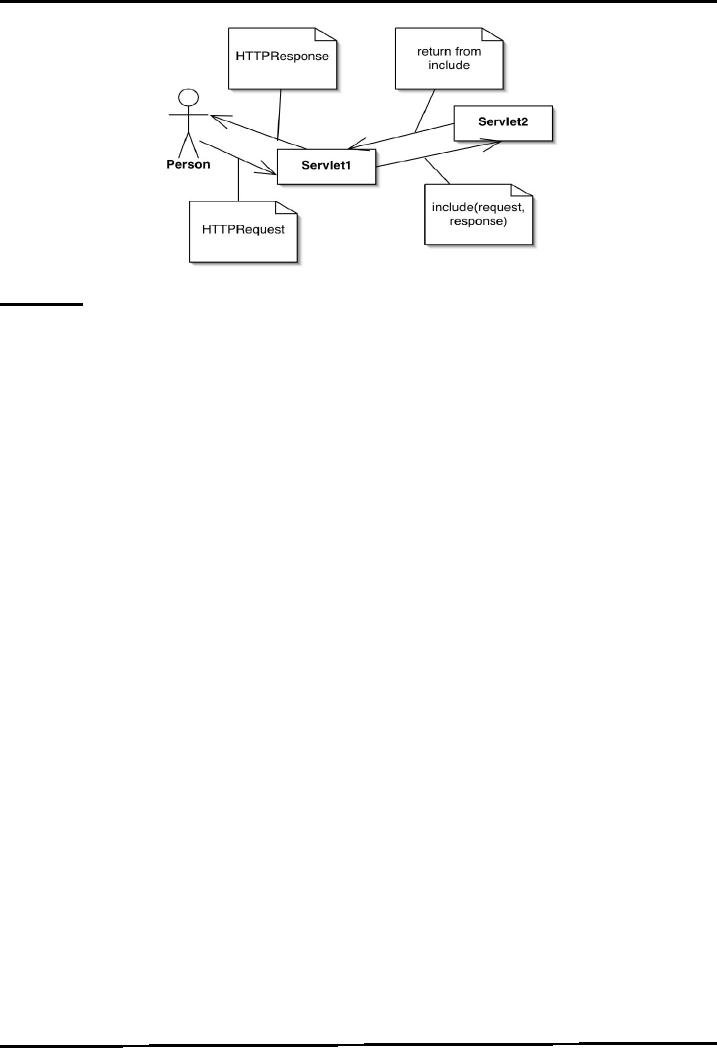 |
JAVA: More on Servlets |
| << JAVA: Servlets Lifecycle |
| JAVA: Dispatching Requests >> |

Web
Design & Development CS506
VU
Lesson
29
More on
Servlets
The
objective of this handout is to
learn about the use and
implementation of initialization
parameters for a
Servlet.
Moreover different ways of redirecting
response and forwarding or including
requests also
discussed
in detail.
Initialization
Parameters
Some
times at the time of starting up the
application we need to provide
some initial information e,g,
name
of the
file where server can store
logging information, DSN for
database etc. Initial
configuration can be
defined
for a Servlet by defining
some string parameters in
web.xml. This allows a
Servlet to have initial
parameters
from outside. This is
similar to providing command
line parameters to a standard
console based
application.
Example:
setting init parameters in
web.xml
Let's
have a look on the way of defining
these parameters in
web.xml
<init-param>
//defining
param 1
<param-name>
param1
</param-name>
<param-value>
value1
</param-value>
</init-param>
<init-param>
//defining
param 2
<param-name>
param2
</param-name>
<param-value>
value2
</param-value>
In the above
code, it is shown that for
each parameter we need to
define separate <initparam>
tag that have
two
sub tags <param-name> and
<param-value>, which contain the
name and values of the parameter
respectively.
ServletConfig
Every
Servlet has an object called
ServletConfig
associated
with it as shown in the fig. below. It
contains
relevant
information about the Servlet
like initialization parameters
defined in web.xml
Reading
Initialization Parameters
Now
let's see, how we can
access init parameters
inside the Servlet. The
method getInitParameter()of
ServletConfig
is usually used to access
init parameters. It takes a
String as parameter, matches it
with
<param-name>
tag under all <init-param>
tags and returns <param-value> from
the web.xml
One
way is to override init() method as shown
in the code below. The
ServletConfig object can
then be
used
to read initialization
parameter.
public
void init(ServletConfig
config)
throws ServletException {
String
name = config.getInitParameter("paramName");
}
Another
way to read initialization
parameters out side the init
() method is
Call
getServletConfig() to obtain the
ServletConfig object
Use
getInitParameter() of ServletConfig to
read initialization
parameters
211

Web
Design & Development CS506
VU
public
void anyMethod() // defined
inside servlet{
ServletConfig
config = getServletConfig();
String
name =
config.getInitParameter("param_name");
}
Example
Code: Reading init parameters
MyServlet.java
will read the init parameter
(log file name) defined
inside web.xml. The code is
given
below:
import
java.io.*;
import
java.net.*;
import
javax.servlet.*;
import
javax.servlet.http.*;
public
class MyServlet extends
HttpServlet {
//
attribute used to store
init-parameter value
String
fileName;
//
overriding init() method
public
void init(ServletConfig config)
throws ServletException{
super.init(config);
//
reading init-parameter "logfilename"
stored in web.xmlfileName =
config.getInitParameter("logfilename");
}
/*
Both doGet() & doPost() methods
are override over
here.processRequest() is called from
both these
methods.
This makespossible for a
servlet to handle both POST
and GET
requestsidentically.
*/
//
Handles the HTTP GET request
type
protected
void doGet(HttpServletRequest
request,
HttpServletResponse
response)throws ServletException,
IOException{
processRequest(request,
response);
}
//
Handles the HTTP POST
request type
protected
void doPost(HttpServletRequest
request,
HttpServletResponse
response)throws ServletException,
IOException{
processRequest(request,
response);
}
//
called from doGet() &
doPost()
protected
void processRequest(HttpServletRequest
request,
HttpServletResponse
response)throws ServletException,
IOException{
PrintWriter
out = response.getWriter();
//
writing init-parameter value
that is store in
fileNameout.println(fileName);
out.close();
}
web.xml
<?xml
version="1.0"
encoding="UTF-8"?><web-app>
<servlet>
<servlet-name> MyServlet </servlet-name>
<servlet-class> MyServlet
</servlet-class>
<init-param>
<param-name>
logfilename
</param-name>
<param-value> logoutput.txt
212

Web
Design & Development CS506
VU
</param-value>
</init-param>
</servlet>
<servlet-mapping>
<servlet-name>
MyServlet </servlet-name>
<url-pattern>
/myservlet </url-pattern>
</servlet-mapping>
</web-app>
Response
Redirection
We
can redirect the response of the
Servlet to another application resource
(another Servlet, an HTML
page
or a JSP) but the resource
(URL) must be available to the
calling Servlet, in the same
Servlet
context
(discussed later).
There
are two forms of response
redirection that can be
possible:
Sending
a standard redirect
Sending
a redirect to an error
page
Sending
a standard Redirect
Using
response.sendRedirect("myHtml.html") method, a
new request is generated
which redirects
the
user to the specified
URL.
If the
URL is of another Servlet, that
second Servlet will not have
access to the original
request
object.
For example, if the request is
redirected from servlet1 to
servlet2, then servlet2
would not
be
able to access the request
object of servlet1.
To have
access to the original request
object, you must use the
request dispatching
technique
(discussed
later) instead of redirect.
Sending
a redirect to an error page
Instead
of using response.sendRedirect(), we can
use response.sendEorror() to show user an
error page.
This
methods takes two
parameters, first the error number
that is a predefined constant of the
response class
(listed
below) and second the appropriate
error message. The steps to
redirect the user to an error
page are:
An
error code is sent as a
parameter of response.sendError(int, msg)method
The
error page is displayed with
the msg passed to method
The
error numbers are predefined
constants of the HttpServletResponse class.
For example:
-SC_NOT_FOUND
(404)
-SC_NO_CONTENT
(204)
-SC_REQUEST_TIMEOUT
(408)
Example
Code: Response Redirection
The
example given below
demonstrates a typical sign on
example in which a user is
asked to provide
login/password,
providing correct information leads to
welcome page or otherwise to a
registration page.
This
example consists of login.html,
welcome.html, register.html and
MyServlet.java files. Let's
examine
these
one after another.
login.html
This
page contains two text
fields; one for entering
username and another for password.
The data from
this
page
is submitted to MyServlet.java.
213

Web
Design & Development CS506
VU
<html>
<body>
<h2>
Please provide login
details</h2>
<FROM
METHOD="POST"
ACTION="http://localhost:8084/redirectionex/myservlet"NAME="myForm"
>
<BR>
User Id:
<INPUT
TYPE="text" name="userid"/>
<BR>
Password:
<INPUT
TYPE="password"
name="pwd"/>
<BR>
<BR>
<input
type="submit" value="Submit
Form"/>
</form>
</body>
</html>
welcome.html
The
user is directed to this
page only if user provides
correct login / password. This
page only displays a
successfully
logged-in message to the
user.
<html>
<body>
<h2>
You have successfully logged in
</h2> </body>
</body>
</html>
register.html
The
user is redirected to this
page in case of providing
incorrect login/password information.
The user can
enter
user id, address and phone number
here to register.
Note:
The code given below
will only show fields to the
user. It does not register
user as no such
functionality
is added into this small
example.
<html>
<body>
<h2>Your
login is incorrect. Please register
yourself</h2>
<FORM
METHOD="POST" ACTION=""
NAME="myForm">
<BR>
Name:
<INPUT
TYPE="text" NAME="userid"/>
<BR>
Address:
<INPUT
TYPE="text" NAME="address"/>
<BR>
Phone No:
<INPUT
TYPE="text" NAME="phoneno"/>
<BR>
<BR>
<input
type="submit"
value="Register"/>
</form>
</body>
</html>
MyServle.java
MyServlet.java
accepts requests from
login.html and redirects the user to
welcome.html or register.html
based
on the verification of username &
password provided. Username &
password are compared with
fix
values in
this example, however you
can verify these from
database or from a text file
etc.
import
java.io.*;
import
java.net.*;
import
javax.servlet.*;
214

Web
Design & Development CS506
VU
import
javax.servlet.http.*;
public
class MyServlet extends
HttpServlet {
//
Handles the HTTP GET request
type
protected
void doGet(HttpServletRequest request,
HttpServletResponse response)throws
ServletException,
IOException{
processRequest(request,
response);
}
//
Handles the HTTP POST
request type
protected
void doPost(HttpServletRequest request,
HttpServletResponse response)throws
ServletException,
IOException{
processRequest(request,
response);
}
protected
void processRequest(HttpServletRequest request,
HttpServletResponse response)throws
ServletException,
IOException{
String
id = request.getParameter("userid");String pwd =
request.getParameter("pwd");
//
comparing id & password with fix
values
if(id.equals("ali")
&& pwd.equals("vu")) {
//
redirectign user to
welcome.html
response.sendRedirect("welcome.html");
else
{// redirecting user to
register.htmlresponse.sendRedirect("register.html");
/* if
you want to display an error
message to theuser, you can
use the following method
response.sendError(response.SC_PROXY_AUTHENTICATION_REQUIRED,"Send
Error
Demo" );*/
}//
end else
}
}
ServletContext
ServletContext
belongs to one web application. Therefore
it can be used for sharing
resources among
servlets in the
same web application.
As
initialization parameters, for a
single servlet are stored in
ServletConfig, ServetContext can
store
initialization
parameters for the entire
web application. These
parameters are also called
context attributes
and
exist for the lifetime of the
application. The following
figure illustrates the sharing of
context attributes
among
all the servlets of a web
application.
Note:
There
is a single ServletContextper web
application
Different
Sevlets will get the same ServletContext
object, when calling
getServletContext()during
different
sessions
Request
Dispatcher
RequestDispatcher
provides a way to forward or
include data from another
source. The method
215

Web
Design & Development CS506
VU
getRequestDispatcher(String
path) of ServletContext returns a RequestDispatcher
object associated
with
the
resource at the given path
passed as a parameter.
Two
important methods of RequestDispatcher
are:
forward(ServletRequest
req, ServletResponse resp)
include(ServletRequest
req, ServletResponse resp)
RequestDispatcher:
forward
Characteristics of
forward methods are:
It
allows a Servlet to forward the
request to another resource (Servlet,
JSP or HTML file) in the
same
Servlet context.
Forwarding
remains transparent to the client unlike
res.sendRedirect(String location). You
can not
see
the changes in the URL.
Request
Object is available to the called
resource. In other words, it remains in
scope.
Before
forwarding request to another source,
headers or status codes can
be set, but
output
content cannot be added.
To
clarify the concepts, lets take the
help from following figure.
User initates the request to
servlet1.
servlet1
forwards the request to servlet2 by
calling forward(request,response). Finally a
response is
returned
back to the user by servlet2.
RequestDispatcher:
include
It
allows a Servlet to include the
results of another resource in its
response. The two major
differences from
forward
are:
Data
can be written to the response
before an include
The
first Servlet which receive the
request, is the one which
finishes the response
It
will be more cleared from the following
figure. User sends a HTTPRequest to
Servlet1. Serlet2 is
called
by
Servlet1 by using include(request,
response) method. The response
generated by Servlet2 sends back
to
Servlet1.
Servlet1 can also add its
own response content and finally
send it back to user.
216

Web
Design & Development CS506
VU
References:
Java
A Lab Course by Umair
Javed
Core Servlets
and JSP by Marty
Hall
Java
API documentation
217
Table of Contents:
- JAVA FEATURES
- Java Virtual Machine & Runtime Environment
- Learning Basics of JAVA
- JAVA: Object Oriented Programming
- JAVA: Inheritance
- JAVA: Collections
- JAVA: Intro to Exceptions
- JAVA: Streams
- JAVA: Modification of Address Book Code
- JAVA: Graphical User Interfaces
- JAVA: Event Handling
- JAVA: More Examples of Handling Events
- JAVA: Problem in Last Code Example
- Java Database Connectivity
- JAVA: More on JDBC
- JAVA: Result Set
- JAVA: Meta Data
- Java Graphics
- JAVA: How to Animate
- JAVA Applets
- JAVA: Socket Programming
- JAVA: Serialization
- JAVA: Multithreading 1
- JAVA: Multithreading 2
- JAVA Web Application Development
- Java Servlets
- JAVA: Creating a Simple Web Application in Tomcat
- JAVA: Servlets Lifecycle
- JAVA: More on Servlets
- JAVA: Dispatching Requests
- JAVA: Session Tracking 1
- JAVA: Session Tracking 2
- JAVA: AddressBook Case Study Using Sevlets
- Java Server Pages 1
- JavaServer Pages 2
- Java Server Pages 3
- JAVA: JSP Action Elements and Scope
- JAVA: JSP Custom Tags
- JAVA: MVC + Case Study
- JAVA: MVC Model 2 Architecture
- JAVA: Layers and Tiers
- JAVA: Expression Language
- JAVA: JavaServer Pages Standard Tag Library (JSTL)
- JAVA: Client Side Validation & JavaServer Faces (JSF)
- JAVA: JavaServer Faces